The Benefits of Using Meeting Agendas

Introduction
In today's fast-paced business environment, effective meetings are crucial for the success of any organization. One essential tool for ensuring that your meetings are productive and engaging is the use of meeting agendas. Meeting agendas not only help in organizing and structuring your meetings but also provide numerous benefits that contribute to better outcomes for your team and organization.
In this article, we will delve into the various advantages of using meeting agendas and provide you with real-life examples of successful implementation. By understanding the importance of meeting agendas and incorporating them into your meeting practices, you can significantly improve the efficiency and effectiveness of your meetings.
The following key benefits of using meeting agendas will be covered:
- Provides clear objectives and expectations
- Saves time and increases productivity
- Keeps everyone focused and on track
- Increases participation and engagement
- Improves decision-making and accountability
- Ensures follow-up and follow-through
Read on to discover how meeting agendas can revolutionize your meetings and contribute to the overall success of your organization.
Provides Clear Objectives and Expectations
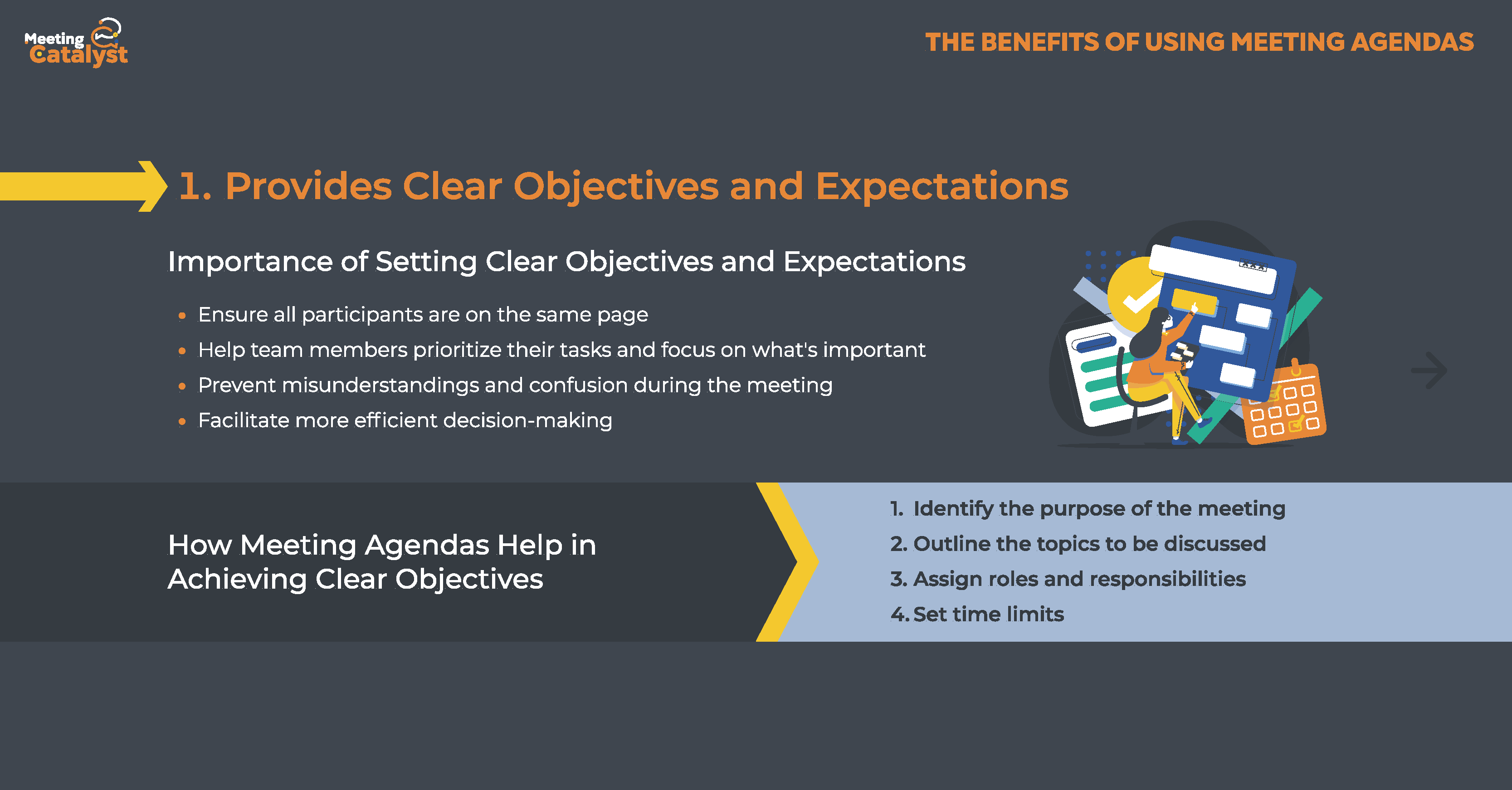
One of the main reasons why meetings can sometimes be unproductive is a lack of clarity in terms of objectives and expectations. A well-defined meeting agenda can help you tackle this issue head-on, ensuring that everyone involved in the meeting knows what to expect and what is expected of them.
Importance of Setting Clear Objectives and Expectations
Clearly defined objectives and expectations serve as the foundation for any productive meeting. By establishing these upfront, you can:
- Ensure all participants are on the same page
- Help team members prioritize their tasks and focus on what's important
- Prevent misunderstandings and confusion during the meeting
- Facilitate more efficient decision-making
How Meeting Agendas Help in Achieving Clear Objectives
Creating a comprehensive meeting agenda enables you to:
- Identify the purpose of the meeting: Clearly state the meeting's goal, ensuring that everyone is aware of what the meeting is meant to achieve.
- Outline the topics to be discussed: List the specific topics or issues that will be addressed during the meeting, providing participants with a clear roadmap.
- Assign roles and responsibilities: Specify the roles and responsibilities of each participant, ensuring everyone understands their part in achieving the meeting objectives.
- Set time limits: Allocate a specific amount of time for each agenda item, helping to manage expectations and maintain focus on the objectives.
Using meeting agendas to set clear objectives and expectations can significantly enhance the productivity and effectiveness of your meetings. By providing a roadmap for discussion and assigning roles and responsibilities, meeting agendas help ensure that everyone is aligned and working towards the same goals.
Saves Time and Increases Productivity
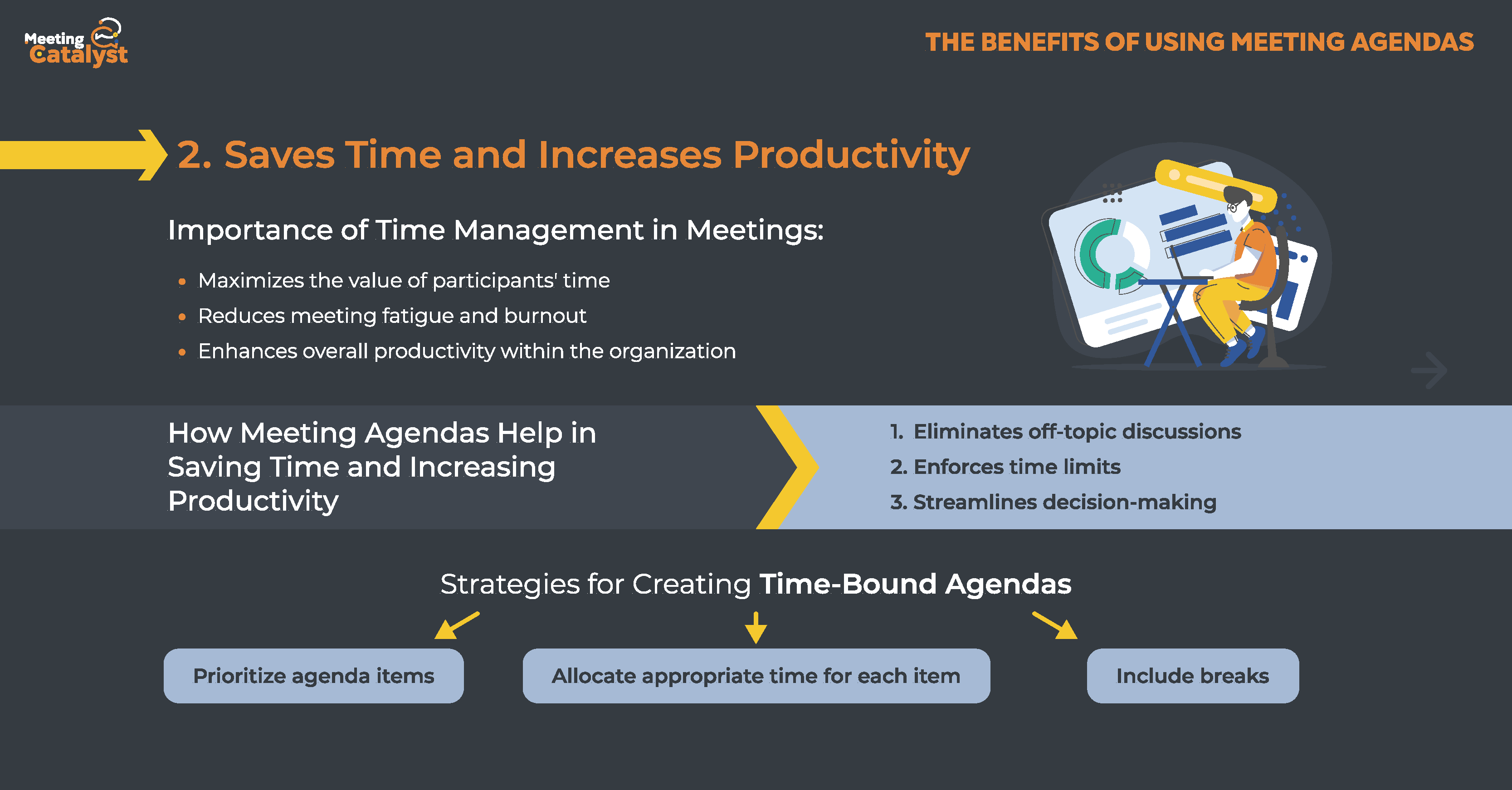
Time is a valuable resource. Meeting agendas can help save time and increase productivity by ensuring that meetings are focused, efficient, and effective. By clearly outlining the discussion points and time allocations, you can eliminate unnecessary conversations and streamline the decision-making process.
Importance of Time Management in Meetings
Effective time management in meetings is crucial for several reasons:
- Maximizes the value of participants' time
- Reduces meeting fatigue and burnout
- Enhances overall productivity within the organization
How Meeting Agendas Help in Saving Time and Increasing Productivity
Meeting agendas contribute to time-saving and increased productivity in the following ways:
- Eliminates off-topic discussions: By providing a clear outline of topics to be discussed, meeting agendas keep participants focused on the relevant issues, reducing the likelihood of time-consuming tangents.
- Enforces time limits: Allocating specific time slots for each agenda item ensures that discussions remain on schedule and prevents meetings from dragging on unnecessarily.
- Streamlines decision-making: By presenting a clear and concise list of discussion points, meeting agendas facilitate more efficient decision-making by allowing participants to come prepared with their thoughts and ideas.
Strategies for Creating Time-Bound Agendas
To make the most of your meeting agendas, consider these strategies:
- Prioritize agenda items: List agenda items in order of importance to ensure that the most pressing issues are addressed first.
- Allocate appropriate time for each item: Estimate the time required for each agenda item and allocate it accordingly, keeping in mind the total duration of the meeting.
- Include breaks: For longer meetings, schedule breaks to give participants a chance to refresh and refocus.
By using meeting agendas to save time and increase productivity, your organization can make the most of its valuable resources and ensure that meetings are efficient, focused, and results-oriented.
Keeps Everyone Focused and on Track
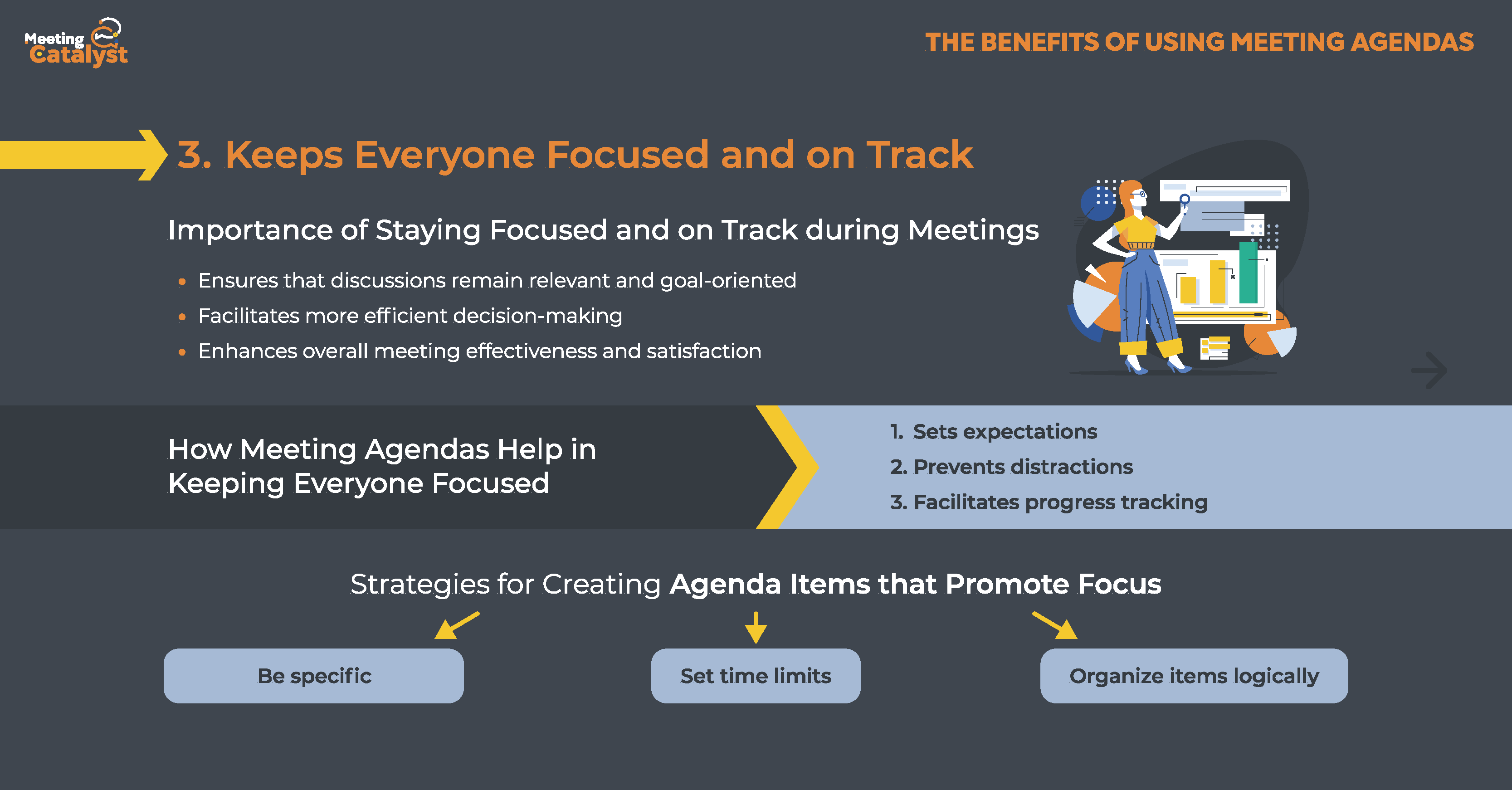
A well-structured meeting agenda not only saves time and increases productivity but also keeps participants focused and on track throughout the meeting. By clearly outlining the topics to be discussed and the expected outcomes, attendees can better understand the purpose of the meeting, remain engaged, and contribute effectively to the conversation.
Importance of Staying Focused and on Track during Meetings
Maintaining focus and staying on track during meetings is essential for the following reasons:
- Ensures that discussions remain relevant and goal-oriented
- Facilitates more efficient decision-making
- Enhances overall meeting effectiveness and satisfaction
How Meeting Agendas Help in Keeping Everyone Focused
Meeting agendas contribute to focus and staying on track in the following ways:
- Sets expectations: Clearly outlining the topics to be discussed helps attendees understand the purpose of the meeting and prepares them to contribute effectively.
- Prevents distractions: By providing a clear structure, meeting agendas minimize the risk of unrelated topics and tangents derailing the conversation.
- Facilitates progress tracking: Meeting agendas serve as a roadmap, allowing participants to monitor progress and ensure that all relevant points are addressed.
Strategies for Creating Agenda Items that Promote Focus
To create an agenda that keeps participants focused, consider these strategies:
- Be specific: Clearly define each agenda item and its objectives to give participants a clear understanding of the topic and its importance.
- Set time limits: Allocate a specific time for each agenda item to ensure discussions remain focused and on track.
- Organize items logically: Arrange agenda items in a logical order to help participants follow the flow of the meeting.
Implementing meeting agendas that keep everyone focused and on track can greatly enhance the overall effectiveness of your meetings, leading to more efficient decision-making, better outcomes, and higher levels of satisfaction among participants.
Increases Participation and Engagement
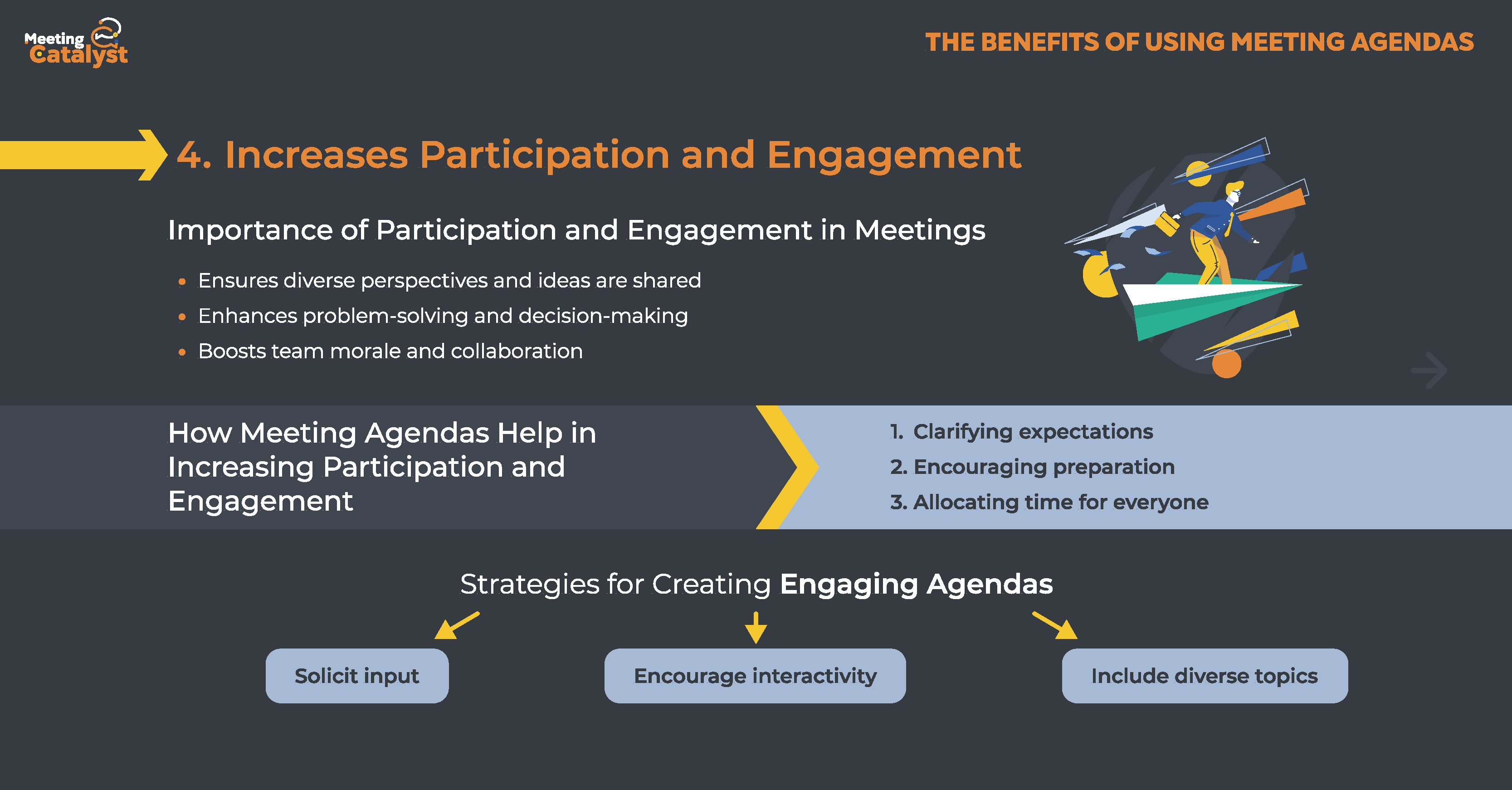
Meeting agendas not only keep participants focused and on track, but they also foster an environment where everyone is encouraged to actively participate and engage. By clearly outlining topics and expectations, attendees feel more prepared to contribute to the conversation, leading to more meaningful discussions and better meeting outcomes.
Importance of Participation and Engagement in Meetings
High levels of participation and engagement in meetings are crucial for the following reasons:
- Ensures diverse perspectives and ideas are shared
- Enhances problem-solving and decision-making
- Boosts team morale and collaboration
How Meeting Agendas Help in Increasing Participation and Engagement
Meeting agendas play a key role in promoting participation and engagement by:
- Clarifying expectations: By outlining the topics and objectives, attendees can better understand their roles and contributions to the discussion.
- Encouraging preparation: When participants know what to expect in advance, they can come prepared with ideas, questions, and solutions to contribute.
- Allocating time for everyone: By designating time for each topic and participant, agendas ensure that everyone has an opportunity to speak and share their insights.
Strategies for Creating Engaging Agendas
To develop meeting agendas that encourage participation and engagement, consider these strategies:
- Solicit input: Involve team members in the agenda creation process, allowing them to suggest topics and questions they would like to discuss.
- Encourage interactivity: Incorporate interactive elements such as brainstorming sessions, group discussions, or breakout rooms to create a more engaging meeting experience.
- Include diverse topics: Ensure your agenda covers a variety of topics that cater to different interests and expertise within your team.
By incorporating well-structured meeting agendas that promote participation and engagement, you can create an environment where diverse ideas and perspectives are shared, ultimately leading to better meeting outcomes, enhanced collaboration, and a more cohesive team.
Improves Decision-Making and Accountability
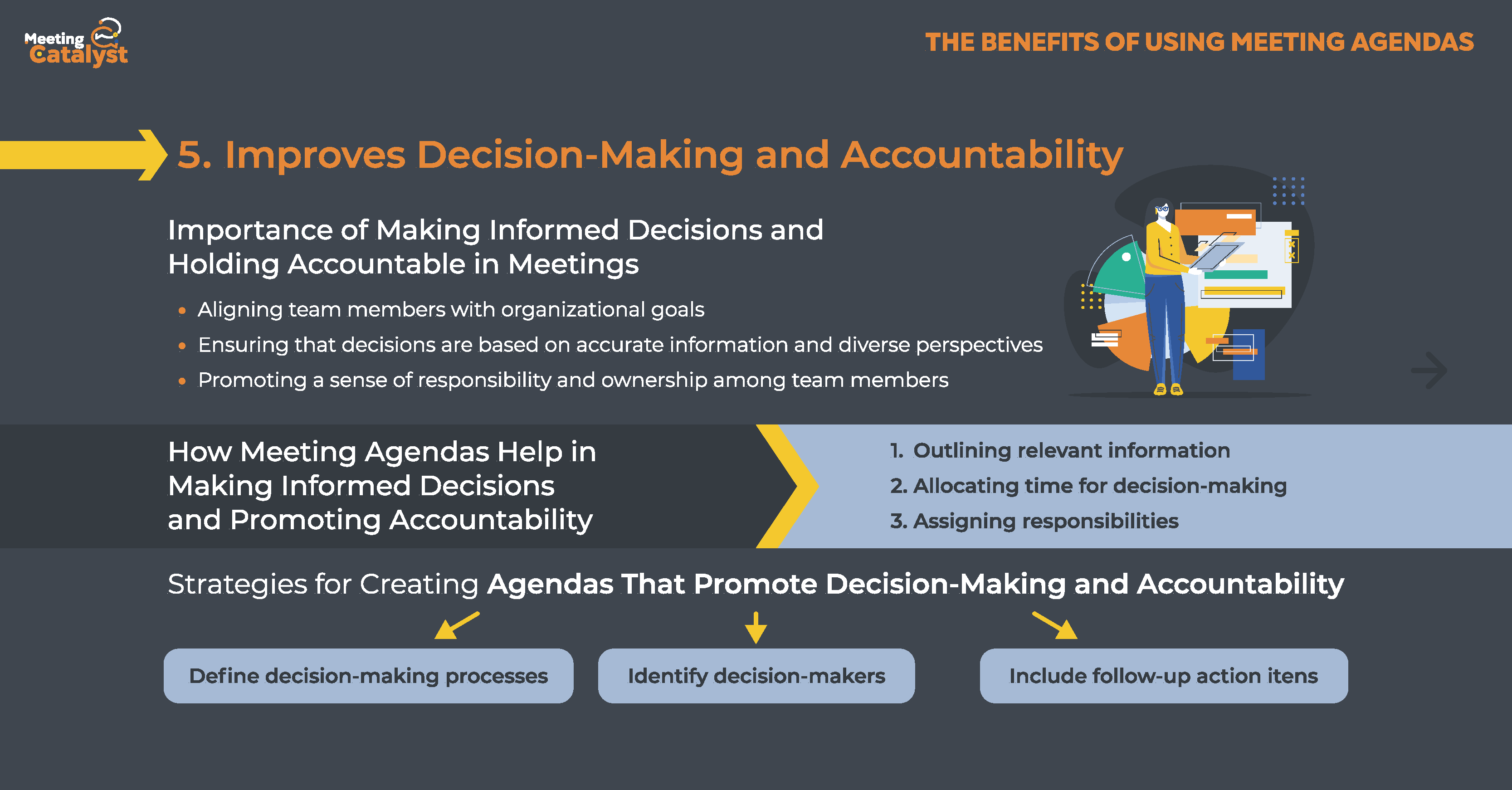
Meeting agendas not only foster participation and engagement, but they also enhance decision-making processes and accountability among team members. By providing a clear structure and objectives, meeting agendas ensure that relevant information is discussed, decisions are made efficiently, and participants understand their responsibilities.
Importance of Making Informed Decisions and Holding Accountable in Meetings
Effective decision-making and accountability are essential for:
- Aligning team members with organizational goals
- Ensuring that decisions are based on accurate information and diverse perspectives
- Promoting a sense of responsibility and ownership among team members
How Meeting Agendas Help in Making Informed Decisions and Promoting Accountability
Meeting agendas contribute to improved decision-making and accountability by:
- Outlining relevant information: By listing the topics to be discussed, meeting agendas ensure that all pertinent information is considered before making decisions.
- Allocating time for decision-making: Agendas can include dedicated time for decision-making processes, such as voting, consensus-building, or open discussions.
- Assigning responsibilities: By assigning specific action items and deadlines to team members, agendas promote accountability and ownership of decisions.
Strategies for Creating Agendas That Promote Decision-Making and Accountability
To develop meeting agendas that support informed decision-making and accountability, consider the following strategies:
- Define decision-making processes: Clearly state the decision-making methods to be used during the meeting (e.g., consensus, majority vote, or executive decision).
- Identify decision-makers: Clearly indicate the roles and responsibilities of each participant, especially those who will be making decisions or leading discussions.
- Include follow-up action items: Incorporate specific action items, deadlines, and responsible parties to ensure accountability and follow-through on decisions made during the meeting.
In summary, well-structured meeting agendas play a critical role in improving decision-making processes and promoting accountability within your team. By implementing these strategies, you can ensure that your meetings are more effective, leading to better outcomes and a more successful organization.
Ensures Follow-Up and Follow-Through
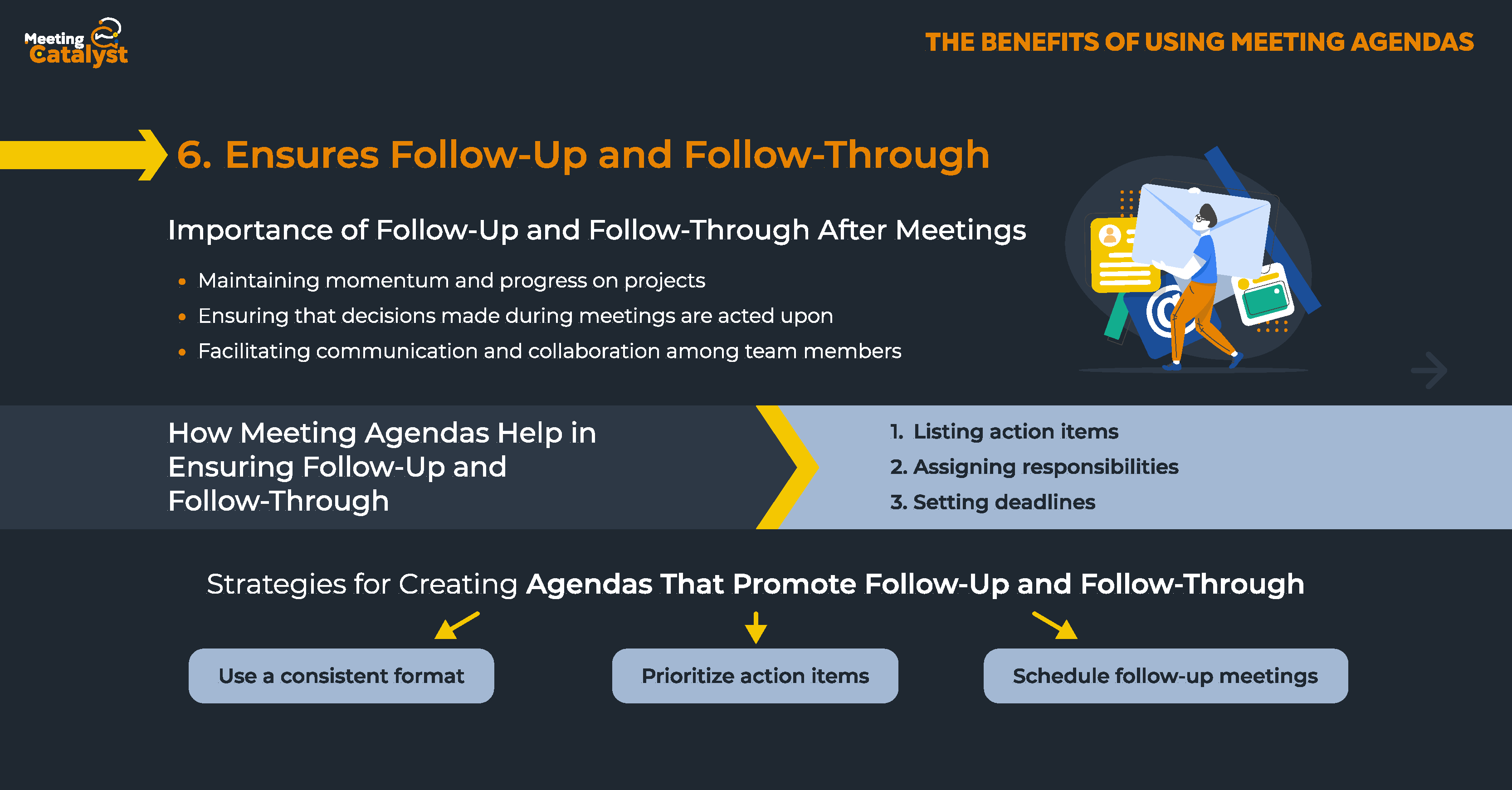
A well-designed meeting agenda not only improves decision-making and accountability but also ensures effective follow-up and follow-through on action items and tasks. By outlining and assigning responsibilities, meeting agendas help to maintain momentum and progress on projects and initiatives.
Importance of Follow-Up and Follow-Through After Meetings
Effective follow-up and follow-through are crucial for:
- Maintaining momentum and progress on projects
- Ensuring that decisions made during meetings are acted upon
- Facilitating communication and collaboration among team members
How Meeting Agendas Help in Ensuring Follow-Up and Follow-Through
Meeting agendas support follow-up and follow-through by:
- Listing action items: Agendas provide a clear and organized overview of tasks and responsibilities to be addressed after the meeting.
- Assigning responsibilities: By specifying who is responsible for each action item, agendas promote a sense of ownership and commitment among team members.
- Setting deadlines: Including deadlines for action items in the agenda helps to ensure timely completion of tasks and keeps the team on track.
Strategies for Creating Agendas That Promote Follow-Up and Follow-Through
To create meeting agendas that foster effective follow-up and follow-through, consider the following strategies:
- Use a consistent format: Adopt a standardized format for listing action items, responsibilities, and deadlines, making it easy for participants to quickly review and understand their tasks.
- Prioritize action items: Organize action items by priority, ensuring that the most critical tasks are addressed first.
- Schedule follow-up meetings: Include follow-up meetings in the agenda to review progress, discuss any challenges, and adjust plans as needed.
Well-crafted meeting agendas can greatly enhance follow-up and follow-through after meetings, ensuring that your team stays on track and accomplishes their goals. By incorporating these strategies into your meeting agenda planning, you can create a more effective and productive team environment.
Conclusion
In today's fast-paced business environment, effective and well-structured meeting agendas are essential for streamlining decision-making, enhancing productivity, and fostering collaboration. As we've explored throughout this blog post, implementing meeting agendas can bring numerous benefits to your team and organization:
- Provides clear objectives and expectations: Meeting agendas set the stage for success by outlining goals, expectations, and the scope of the discussion.
- Saves time and increases productivity: Agendas help to manage time effectively and ensure that meetings are efficient and result-oriented.
- Keeps everyone focused and on track: By providing a roadmap for discussion, agendas ensure that meetings remain focused and relevant.
- Increases participation and engagement: A well-structured agenda encourages active participation and keeps team members engaged and invested in the meeting.
- Improves decision-making and accountability: Agendas support informed decision-making and promote a sense of ownership and responsibility among team members.
- Ensures follow-up and follow-through: By clearly outlining action items, responsibilities, and deadlines, agendas facilitate effective follow-up and follow-through on tasks and projects.
Incorporating meeting agendas into your organizational practices can significantly improve the quality of your meetings, leading to better outcomes and a more productive team. By utilizing the strategies and best practices discussed in this post, you can create effective agendas that optimize meeting time, foster collaboration, and drive your team towards success.